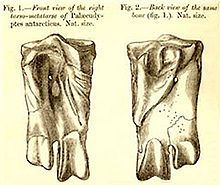| Palaeeudyptes Temporal range:
| |
|---|---|

| |
| Huxley’s original illustration of the fossil of an ankle bone from Palaeeudyptes antarcticus described in 1859. | |
| Scientific classification | |
| Domain: | Eukaryota |
| Kingdom: | Animalia |
| Phylum: | Chordata |
| Class: | Aves |
| Order: | Sphenisciformes |
| Family: | Spheniscidae |
| Subfamily: | †Palaeeudyptinae |
| Genus: | †Palaeeudyptes Huxley, 1859[1] |
| Type species | |
| Palaeeudyptes antarcticus Huxley, 1859
| |
| Species | |
|
Palaeeudyptes antarcticus | |
| Synonyms | |
Palaeeudyptes is an extinct genus of large penguins, currently containing four accepted species. They were probably larger than almost all living penguins, with the smaller species being about the size of an emperor penguin, and the largest species, Palaeeudyptes klekowskii, estimated to reach 2 meters (6.6 ft) long (measuring tip of beak to tail) and weighed up to 116 kg (256 lb).[3]
- ^ Huxley, Thomas Henry (February 1859). "On a Fossil Bird and a Fossil Cetacean from New Zealand". Quarterly Journal of the Geological Society of London. 15 (1–2): 670–677. doi:10.1144/GSL.JGS.1859.015.01-02.73. ISSN 0370-291X. S2CID 130362530.
- ^ Simpson, George Gaylord (28 September 1971). "Review of Fossil Penguins from Seymour Island". Proceedings of the Royal Society B. 178 (1053): 357–387. Bibcode:1971RSPSB.178..357S. doi:10.1098/rspb.1971.0070. JSTOR 75962. S2CID 84900109.
- ^ Hospitaleche, Carolina A. (2014). "New giant penguin bones from Antarctica: Systematic and paleobiological significance". Comptes Rendus Palevol. 13 (7): 555–560. Bibcode:2014CRPal..13..555A. doi:10.1016/j.crpv.2014.03.008. hdl:11336/32571.